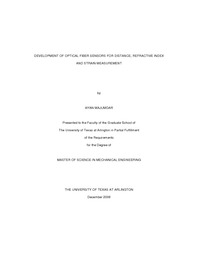
ATTENTION: The works hosted here are being migrated to a new repository that will consolidate resources, improve discoverability, and better show UTA's research impact on the global community. We will update authors as the migration progresses. Please see MavMatrix for more information.
Show simple item record
| dc.contributor.author | Majumdar, Ayan | en_US |
| dc.date.accessioned | 2009-09-16T18:16:40Z | |
| dc.date.available | 2009-09-16T18:16:40Z | |
| dc.date.issued | 2009-09-16T18:16:40Z | |
| dc.date.submitted | January 2008 | en_US |
| dc.identifier.other | DISS-10025 | en_US |
| dc.identifier.uri | http://hdl.handle.net/10106/1641 | |
| dc.description.abstract | This thesis is focused on the development of optical fiber based sensors for the measurement of distance, refractive index, and strain. The fabrication, implementation, analysis, and evaluation of the sensors are presented. The Extrinsic Fabry-Perot Interferometric (EFPI) distance sensor is one of the most popular distance sensors but it possesses an inherent drawback. When the free-space cavity distance is very small, the numbers of fringes generated are not sufficient for the distance demodulation algorithm; therefore the smallest distance it can measure is determined by the bandwidth of the light source. An optical fiber based distance sensor is developed in this thesis which is capable of overcoming this shortcoming by taking advantage of the mode coupling effect of a Long Period Fiber Grating (LPFG). The optical path difference (OPD) is contributed by the free-space cavity distance as well as the LPFG cavity distance; therefore it can generate sufficient fringes even when the free space cavity distance is very small. A sensor probe with a metallic coating over its cladding region only is fabricated and a mechanically induced LPFG is implemented. The performance of the sensor is evaluated. It is confirmed that the LPFG-based distance sensor is capable of measuring distances as small as 4 microns which is significantly smaller than that can be measured by an EFPI sensor. A compact polymer tip based distance sensor is subsequently developed to overcome the shortcomings of the LPFG. The sensor consists of a polymer core fabricated at the end of the optical fiber. Similar to the LPFG based distance sensor, the OPD for this sensor is contributed by the free-space cavity distance as well as the phase shift introduced by the polymer core which helps it generate sufficient fringes for the distance demodulation. The sensor probe fabricated for the polymer tip based distance sensor is extended to refractive index measurement by submerging the polymer core in the liquid whose refractive index needs to be measured. The effective refractive index of the polymer core changes with the external refractive index, producing a phase shift in the interference spectrum. In order to understand the performance of the refractive index sensor, a simulation model is developed. This simulation model is subsequently validated by the experimental data. A high sensitivity of 0.6 nm in fringe shift for every 0.01 change in refractive index is achieved experimentally when the sensor is immersed in different refractive index standards. The sensor also shows a 60% increase in sensitivity when compared with similar LPFG or interferometry-based refractive index sensors. A strain sensor that is capable of measuring large strains is also developed by fabricating a polymer sensing element between two multi-mode fibers, using the sample polymer core fabrication process. It is experimentally validated that a strain as large as 56% can be measured using this hybrid glass/polymer sensor. The work to be done in the future in order to make these sensors commercially viable is also discussed. | en_US |
| dc.description.sponsorship | Huang, Haiying | en_US |
| dc.language.iso | EN | en_US |
| dc.publisher | Mechanical Engineering | en_US |
| dc.title | Development Of Optical Fiber Sensors For Distance, Refractive Index And Strain Measurement | en_US |
| dc.type | M.S. | en_US |
| dc.contributor.committeeChair | Huang, Haiying | en_US |
| dc.degree.department | Mechanical Engineering | en_US |
| dc.degree.discipline | Mechanical Engineering | en_US |
| dc.degree.grantor | University of Texas at Arlington | en_US |
| dc.degree.level | masters | en_US |
| dc.degree.name | M.S. | en_US |
| dc.identifier.externalLink | https://www.uta.edu/ra/real/editprofile.php?onlyview=1&pid=1676 | |
| dc.identifier.externalLinkDescription | Link to Research Profiles | |
Files in this item
- Name:
- Majumdar_uta_2502M_10025.pdf
- Size:
- 4.595Mb
- Format:
- PDF
This item appears in the following Collection(s)
Show simple item record


